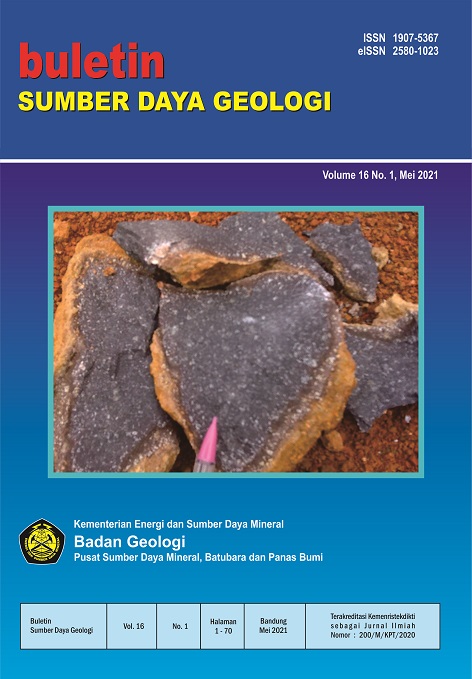STUDI KOMPARASI PEMODELAN INVERSI 1-D, 2-D, DAN 3-D DATA MAGNETOTELLURIK DI DAERAH PANAS BUMI LOKOP, PROVINSI ACEH
COMPARATIVE STUDY OF MAGNETOTELLURIC 1-D, 2-D, AND 3-D INVERSION MODELLING AT LOKOP GEOTHERMAL AREA, PROVINCE OF ACEH
Abstract
Magnetotelluric (MT) method can determine conductivity structure in geothermal area which could be interpretated as smectite clay (clay cap) is commonly used to help target geothermal wells and assess resource capacity. In order to process MT data, we can do 1-D, 2-D, and 3-D inversion modelling to produce a realistic MT model data. 1-D inversion is very easy to do, where this model can support an effective quality assurance of each MT station data. 1-D inversion is usually able to characterize the overall resistivity geometry of a geothermal clay cap, although not abrupt edges or deep variations. In order overcome this uncertainty, 2-D inversion can be performed. However, 2-D inversion can't work properly if our MT survey in complicated geological environments.The limitations of 1-D and 2-D inversions can be fixed by performing 3-D inversion. The modelling application was carried out using MT data in Lokop geothermal area, Province of Aceh.1-D and 3-D modeling result can better describe the possibility of clay cap in Lokop geothermal area.
Downloads
References
Anderson, E., Crosby, D., dan Ussher, G., 2000, BULL-EYE! – Simple Resitivity Imaging to Reliably Locate the Geothermal Reservoir, Proceeding Word Geothermal Congress 2000, Kyushu – Tohoku, Japan, May 28 – June 10, 2000
Cagniard, L., 1953, Basic theory of the magnetotelluric method of geophysical prospecting: Geophysics, 18, 605-635
Cumming, W., dan Mackie, R., 2010, Resistivity Imaging of Geothermal Resources Using 1D, 2D, and 3D MT Inversion ans TDEM Static Shift Correction Illustrated by a Glass Mountain Case History, Proceedings World Geothermal Congress 2010, Bali, Indonesia, 25-29 April 2010.
Johnston, J.M., Pellerin, L., dan Hohmann, G. W., 1992, Evaluation of Electromagnetic Methods for Geothermal Reservoir Detection, Geothermal Resources Council Transactions, Vol 16, October 1992.
Keller, G. V., dan Frischknecht, F. C., 1966, Electrical methods in geophysical prospecting, Pergamon Press Ltd., Oxford, 527 pp.
Larsen, J. C., 1975, Low frequency (0.1-6.0 cpd) electromagnetic study of the deep mantle electrical conductivity beneath the Hawaiian Island: Geophys. J. Roy. Astr. Soc., 43, 17-46.
Miensopust, M.P., Queralt, P., dan Jones, A.G., 2013, Magnetotelluric 3-D Inversion - a Review of Two Successful Workshops o Forward and Inversion Code Testing and Comparison, Geophys. J. Int. (2013) 193, 1216 - 1238, Advance Access Publication 2013 March 13.
Petrick. W. R., Pelton, W. H., dan Ward, S. H., 1977, Ridge regression inversion applied to crustal resistivity sounding data from South Africa: Geophysics, 42, 995-1005.
Robertson, K., Thiel, S., dan Meqbel, N., 2020, Quality over quantity : workfloe and model space exploration of 3D inversion of MT data, Earth, Planet and Space (2020) 72:2.
Rooney, D., dan Hutton, V. R., 1977, A magnetotelluric and magneto-variotional study of the Gregory Rift Valley, Kenya: Geophys. J. Roy. Astr. Soc., 51, 91-119.
Simpson, F., dan Bahr, K., 2005, Practical Magnetotellurics, Georg - August - Universitat, Gottingen, Cambridge University Press
Siripunvaraporn, W., Egbert, G., Lenbury, Y., dan Uyeshima, M., 2005, Three-dimensional magnetotelluric inversion: data-space method, Physics of the Earth and Planetary Interiors 150 (2005) 3-14.
Stanley, W. D., Boehl, J. E., Bostick, F. X., Jr., dan Smith, H. W., 1977, Geothermal significance of magnetotelluric soundings in the Snake River Plain - Yellowstone region : J. Geophys. Res., 82, 2501-2514.
Swift, C. M., 1967, A magnetotelluric investigation of an electrical conductivity anomaly in the southwestern United States: Ph.D. thesis, Massachusetts Institute of Technology, 211 p.
Tietze, K., dan Ritter, O., 2013, 3D Magnetotelluric Inversion in Pratice - The electrical Conductivity Structure of the San Andreas Fault in Central California.
Uchida, T., 2005, Three-Dimensional Magnetotelluric Investigation in Geothermal Fields in Japan and Indonesia, Proceedings World Geothermal Congress 2005, Antalya, Turkey, 24-29 April 2005.
Uchida, T., dan Sasaki, Y., 2006, Stable 3D Inversion of MT data and its application to geothermal exploration, Exploration Geophysics (2006) 37, 223-230.
Vozoff, K., 1972, The magnetotelluric metho in the exploration of sedimentary basins: Geophysics, 37, 98-141.
Wannamaker, P. E., 1983, Resistivity structure of the Northern Basin and Range, in The role of heat in the development of energy and mineral resources in the Northern Basin and Range Province : Geothermal Resources Council, Special Rep., 13, 345-362.
Wannamaker, P. E., Hohmann, G. W., dan Ward, S. T., 1984, Magnetotelluric responses of three-dimensional bodies in layered earths, Geophyisics, Vol 49, No 9 (September 1984); P. 1517-1533, 21 Figs.
Word, D. R., Smith, H. W., dan Bostick, F. X., Jr., 1970, An investigation of the magnetotelluric tensor impedance method: Elec. Geophys. Res. Lab. Report 82, Elec. center, Univ. of Texas at Austin, 264 p.
Copyright (c) 2021 Buletin Sumber Daya Geologi

This work is licensed under a Creative Commons Attribution-NonCommercial-ShareAlike 4.0 International License.
Authors whose manuscripts are published agree to the following terms:
The publication rights of all journal manuscript materials published on the Buletin Sumber Daya Geologi website are held by the editorial board with the knowledge of the author (moral rights remain with the manuscript’s author).
The formal legal provisions for access to digital articles in this electronic journal are subject to the terms of the Creative Commons Attribution-ShareAlike (CC BY-SA) license. This means that Buletin Sumber Daya Geologi has the right to store, convert media/formats, manage in the form of a database, maintain, and publish the article without requesting permission from the author, as long as the author’s name is cited as the copyright holder.
Manuscripts published in both print and electronic formats are open access for educational, research, investigative, and library purposes. Beyond these purposes, the editorial board is not responsible for any violations of copyright law.















